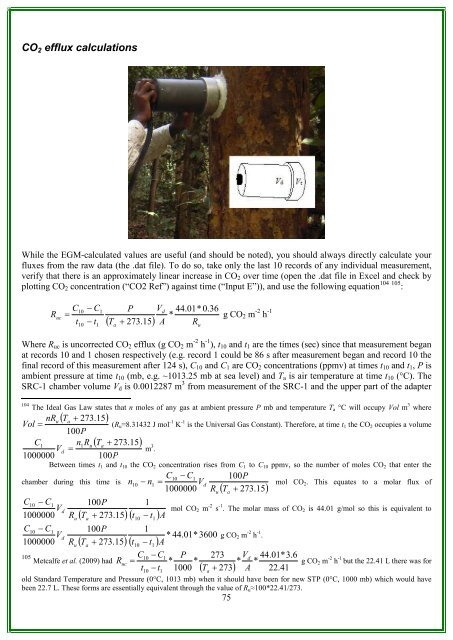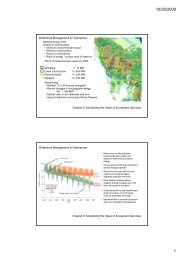RAINFOR GEM Intensive Plots Manual (pdf) - University of Oxford
RAINFOR GEM Intensive Plots Manual (pdf) - University of Oxford
RAINFOR GEM Intensive Plots Manual (pdf) - University of Oxford
- No tags were found...
You also want an ePaper? Increase the reach of your titles
YUMPU automatically turns print PDFs into web optimized ePapers that Google loves.
CO 2 efflux calculationsWhile the EGM-calculated values are useful (and should be noted), you should always directly calculate yourfluxes from the raw data (the .dat file). To do so, take only the last 10 records <strong>of</strong> any individual measurement,verify that there is an approximately linear increase in CO 2 over time (open the .dat file in Excel and check byplotting CO 2 concentration (“CO2 Ref”) against time (“Input E”)), and use the following equation 104 105 :RucCPV10 1d= *g CO 2 m -2 h -1t10− C− t144.01* 0.36( Ta+ 273.15) A RuWhere R uc is uncorrected CO 2 efflux (g CO 2 m -2 h -1 ), t 10 and t 1 are the times (sec) since that measurement beganat records 10 and 1 chosen respectively (e.g. record 1 could be 86 s after measurement began and record 10 thefinal record <strong>of</strong> this measurement after 124 s), C 10 and C 1 are CO 2 concentrations (ppmv) at times t 10 and t 1 , P isambient pressure at time t 10 (mb, e.g. ~1013.25 mb at sea level) and T a is air temperature at time t 10 (°C). TheSRC-1 chamber volume V d is 0.0012287 m 3 from measurement <strong>of</strong> the SRC-1 and the upper part <strong>of</strong> the adapter104 The Ideal Gas Law states that n moles <strong>of</strong> any gas at ambient pressure P mb and temperature T a °C will occupy Vol m 3 whereVolnR( T + 273.15)u a= (R u =8.31432 J mol -1 K -1 is the Universal Gas Constant). Therefore, at time t 1 the CO 2 occupies a volumeCV1000000100Pn R1 1 u a+d( T 273.15)= m 3 .100PBetween times t 1 and t 10 the CO 2 concentration rises from C 1 to C 10 ppmv, so the number <strong>of</strong> moles CO 2 that enter thechamber during this time is10− nC10 − C1100P1Vd1000000 R−u( T + 273.15) ( t t )Aa1C10− C1= V1000000C10− C1100P1Vd* 44.01*36001000000 Ru( Ta+ 273.15) ( t10− t1) AC10− C1P 273Ruc* *t − t 1000 T + 273dRu( T + 273.15)75100Pn mol CO 2 . This equates to a molar flux <strong>of</strong>101amol CO 2 m -2 s -1 . The molar mass <strong>of</strong> CO 2 is 44.01 g/mol so this is equivalent tog CO 2 m -2 h -1 .44.01*3.6105 Metcalfe et al. (2009) hadd* *( ) A 22. 41101aV= g CO 2 m -2 h -1 but the 22.41 L there was forold Standard Temperature and Pressure (0°C, 1013 mb) when it should have been for new STP (0°C, 1000 mb) which would havebeen 22.7 L. These forms are essentially equivalent through the value <strong>of</strong> R u ≈100*22.41/273.





